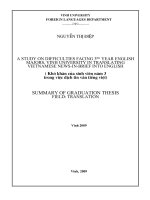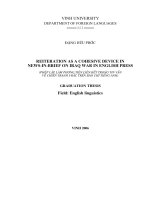- Trang chủ >>
- Luật >>
- Luật thương mại
COURSE DISCRIPTION IN BRIEF
Bạn đang xem bản rút gọn của tài liệu. Xem và tải ngay bản đầy đủ của tài liệu tại đây (132.52 KB, 29 trang )
COURSE DISCRIPTION IN BRIEF
I. On the Comparative Law (CL)
1. Name of this legal science branch:
- Among different countries: not unanimous (e.g.: in
French, droit comparé = compared law; in German,
Rechtsvergleichung = comparision of law)
- Within a country (US): not unanimous either
E.g.: Legal scholars: Comparative law; Comparative legal
traditions…; Legal linguists: Comparative Jurisprudence
Which name should be used? COMPARATIVE LAW
2. The terms & concepts used in CL
• Terms & Concepts: vary from country to country
Eg.:
+ Different Terms: “legislature” (Eg.: US v. UK)
+ Different Concept: “high court” (Eg.: Australia v. UK)
• Legal Jargon: might differ from those used & understood
in even other law subjects:
Eg:
- Legal system;
- Civil Law;
- Common Law.
3. CL as a branch of legal science
- In XIX, beginning of CL was taken up with discussions
attempting:
+ to define its aims, nature,
+ to establish its place among the sciences,
+ to characterize its methods, possible applications & general
usefulness
- CL has developed enormously since beginning of XX 1st
International Congress for CL held (in Paris, 1900)
Views expressed here led to productive research in CL
Till 1970s, most comparatists were inclined to doubt the
existence of the science of CL (merely a variety of study
methods of jurisprudence)
II. ON THE COMPARATIVE LAW SUBJECT
1. CL as an academic discipline in the LLB
curriculum
- In a number of countries around the world:
+ 1st half of the XX, CL still occupied a modest
position in academic curricula (France, Germany, UK,
US..): CL: a selective subject
+ Nowadays (international integration process…)
CL: mandatory subject
- In Vietnam: early 21st century (27th intake, HLU)
2. CL Course Syllabus
Two main parts:
- General Consideration Part: Fundamentals of CL and
CL subject (concept/features/objects/method..)
- Specific Part: Fundamentals of Legal Families / Legal
Systems
Note: Disputed viewpoints on the CL subject’s specific part:
can be classified into 2 groups of subject:
Group 1: Structural Research Subj.: relationship b/t legal
families, legal systems; b/t internal components of legal
systems
Group 2: Law Branch Research Subj.: comparing law
branches of different countries (e.g.: ….)
3. CL Course’s overall objectives
(p4-5 Course Outline)
- Cognition (deep discipline knowledge; legal, cultural,
historical, geographical… knowledges)
- Skills (comparing, collecting inf., analyzing,
synthesizing…)
- Attitude (self-improving of perception of foreign legal
systems/law; more objective in assessment of domestic
law…)
- Other objectives: (p.5)
4. CL subject’s achievement & future
- In the past: CL a res. method used in legal
science
- Nowadays: CL a branch of legal science, a
law discipline in LLB curriculum
- Future: increasingly important (a trend: CL subject
& many specialized CL subjects in law school
curricula)
5. Learning Resources
- See Course Outline, 2017 (p.12-15);
- Note: + Poor in VN but Rich in foreign languages materials
+ Mandatory & Additional materials
1. Micheal Bogdan, “Comparative Law”, Kluwer / Norstedts Juridik /
Tano, 1994; (*)
2. M.A. Glendon, M.W. Gordon, P.G. Carozza, “Comparative Legal
Traditions in a Nutshell”, 2nd Ed, West Group, 1999; (*)
3. K. Zweigert & H. Kotz, “Introduction to Comparative Law”, 3rd Ed,
Oxford University Press, 1998;
4. R. David & J.C. Brierley, “Major Legal System in the World Today”,
3rd Ed, 1985 (reprinted 1996).
5. P. de. Cruz, ”Comparative Law in a Changing World”, Cavendish
Publishing Ltd, 1999.
III. COLLECTING INFORMATION
FOR SELF-STUDY PURPOSE
- From books, journal articles: Vietnamese vs.
Foreign languages
- From Website:
+ westlaw.com; lexis.com; heinonline.org
+ … gov…; …edu…; …aca…
COURSE ASSESSMENT METHODS
• Two assignments (Note: language);
• Final Exam: true/false questions with
explanation
CHAPTER I: COMPARATIVE LAW IN BRIEF
I. General Considerations (M. Bogdan: pp. 17-26;
Glendon..: pp. 1-15)
II. Historical Development of CL (Zweigert, pp. 4862)
III. Theoretical and Empirical Significance of CL (M.
Bogdan: p.25-38)
IV. Grouping of Legal Systems (M. Bogdan: p. 82-91)
V. Comparative Law as an Academic Discipline
Lecturing: Part I; Self-study: Parts: II-V
I. General considerations
1. What is Comparative Law (CL)?
a. The term “CL”: no unique term used:
+ amongst different countries
+ in a country
b. Definition of CL
-
No single definition
3 definitions by 4 authors (VN, German, Swedish)
(1) VN author: CL: “a method of scrutinizing, studying &
approaching law on the basis of internationally legal
exchange”
Good aspects: condensed; linguistic elegance
Not so good aspects:
+ CL = method >< newly emerging international
tendency
+ Research object: too general/broad
(2) German authors: Zweigert & Kotz:
- CL: “An intellectual activity with law as its
object & comparison as its process”; “the
comparison of different legal system of the
world” (p.2)
Good aspects: condensed; linguistic elegance
Not so good aspects:
+ research object: too general/vague
+ research method: too poor
(3) Swedish author: Michael Bogdan
CL encompasses:
“the comparing of different legal system with purpose of ascertaining
their similarities & differences;
working with the similarities & differences that have been ascertained,
for instance explaining their origin, evaluating of the solutions utilized
in the different legal systems, grouping of legal systems into families
of law, or searching for the common core of the legal system; &
the treatment of the methodological problems which arise in
connection with these tasks, including methodological problems
connected to the study of foreign law.” (p.18)
Good…: (full image of CL; concrete objects, methods, aims)
Not so good...: (too long..)
Note: M. Bogdan:
- Comparing 2 law branches/institutes/rules of 2 countries CL =
comparative method
- Comparing abstract legal issues CL = independent legal science
c. Features of CL
(1) Not a law branch, nor a system of legal rules
)2) Used to compare different legal systems
Note: compare between legal acts, rules of the same legal system,
enacted by different ruling powers, in different historical stages
not CL
(3) Study of CL ≠ study of foreign law
(4) CL: branch of legal science, not simply a research method
(5) CL’s research scope seems unlimited:
+ Cannot be treated in an exhaustive manner
+ Can hardly imagine all conceivable bilateral & multilateral
comparisons b/t all combination of existing legal systems
NOTE: Should limit research scope to particular legal
questions/countries
2. CL’s research objects
a. What does CL study? Relation b/t legal systems (LS), their
components; relation b/t groups of LS & reasons for their
similarities & differences concepts to be clarified:
- LS: (1) systematic collection of legal rules/principles (≠ morality,
politics, physics..)
(2) independent system of government (recognized..)
(3) legal institutions operating within a geographic area
(4) an operating set of legal institutions,
procedures & rules
- Legal family (LF): group of LSs having similarities b/c of having
same deeply historical root; & same legal roles in society and in
human ideology LF ≠ LS E.g.: LFs
- Legal tradition (LT): set of historical conditioned attitudes to the
role of law in a particular society, its characteristic mode of legal
thought & its legal sources & basic ideology
Note: How to use terms: LS, LF, LT.
b. CL’s research scope
(1) National LS: relation b/t 2/more national LSs:
+ legal rules, institutions, legal thinking mode…;
+ mechanism of law application;
+ legal profession;
+ legal education.
(2) LF: relation b/t 2/more LFs limit scope of research
(3) International law :
+ when comparing b/t national & international law
+ a regular research subject in international integration
process
c. Levels of comparison:
Macro & Micro comparison
- What are they?
+ Macro C. (large Re. object): b/t LSs; b/t LFs E.g…
Note: bilateral & multilateral comparison
# C/p b/t 2 legal systems Bilateral (Eg)
# C/p b/t more than 2 legal systems Multilateral (Eg)
+ Micro C. (small Re. object): b/t legal rules; legal
institutes E.g.?
- Relation b/t the 2 levels of comparison
3. CL’s research methods
a. Methods
- Which methods?
- Differentiate b/t comparative method (CMe) & CL:
CL
+ Point out similarities
& differences
+ Analyze, explain, comment
+ Concrete conclusion
CMe
+ Point out similarities
& differences
b. Steps in comparison of law
- How many approaches to accomplish a CL
research project?
- Six steps:
+ Pose a question/hypothesis
+ Choice of law
+ Collecting reference materials
+ Building up system of concepts
+ Writing a report on research object
+ Evaluation of research findings
(1) Posing question/hypothesis
- Result from:
(a) Dissatisfaction (eg.) foreign law must be different..
(b) Disinterested study (eg.) how does foreign law look
like..
Enter first step
(2) Choice of laws to compare
- What should be compared?
+ not unique
+ not incomparable
+ same function
- Which country’s law to be chosen?
+ same level of development
+ more developed
+ similar cultural, historical development…?
(3) Collecting reference materials
- Why collect?
- How to collect?
+ General vs. Specific research;
+ Ancient vs. Modern legal regime
(4) Building up system of concepts
- Why?
- How?









